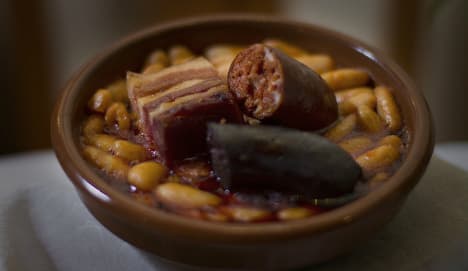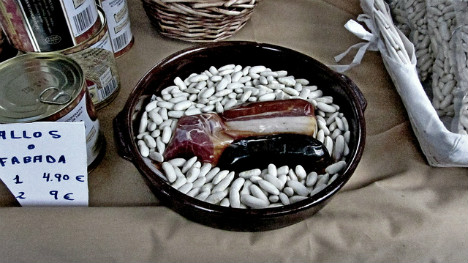Recipe: How to make fabada - traditional Asturian bean stew

The hearty Asturian dish is a perfect lunch on a cold day... and don't forget the crusty bread and cider!
Fabada is a traditional and hearty white bean stew from the northern Spanish region of Asturias. Particularly popular during the colder months, it is traditionally eaten with crusty bread and a glass of Asturian cider.
Luis Valerio from thespanishcuisine.com lets us in on his recipe for the Spanish classic.
Ingredients
15oz of white beans
Two Spanish chorizo
Two Spanish morcilla (black pudding/blood sausage)
One tsp salt
10-12 threads of saffron

The ingredients you need for your fabada. Photo: jimarai/Flickr
Recipe
1. Remove and discard any broken beans.
2. Place the white beans in a large bowl and pour over enough cold water to cover them and set aside overnight to soak (depending on the white bean variety you use, this time could be different).
3. Prick the Spanish chorizo and blood sausages several times all over.
4. Put the soaked white beans, chorizos, blood sausages and one teaspoon of salt in a pot and fill with enough water to cover all the beans, plus one inch more. Make sure the chorizo and blood sausage are above the white beans.
5. Cover the pot, bring it to a boil and simmer over low heat for 30 minutes. Then skim the froth off (to reduce fat), add two - three tablespoons of cold water to stop the boil for an instant, then cover again and continue simmering.
6. Repeat the last step three more times, add the saffron threads and repeat the last step one time more (two and a half hours in total).
7. Transfer the chorizo and blood sausage to a plate, slice them and return them to the pot.
Traditionally this recipe is also cooked with some pork belly and Spanish ham, but you can cook it just with chorizo!
15 oz
Comments
See Also
Fabada is a traditional and hearty white bean stew from the northern Spanish region of Asturias. Particularly popular during the colder months, it is traditionally eaten with crusty bread and a glass of Asturian cider.
Luis Valerio from thespanishcuisine.com lets us in on his recipe for the Spanish classic.
Ingredients
15oz of white beans
Two Spanish chorizo
Two Spanish morcilla (black pudding/blood sausage)
One tsp salt
10-12 threads of saffron

The ingredients you need for your fabada. Photo: jimarai/Flickr
Recipe
1. Remove and discard any broken beans.
2. Place the white beans in a large bowl and pour over enough cold water to cover them and set aside overnight to soak (depending on the white bean variety you use, this time could be different).
3. Prick the Spanish chorizo and blood sausages several times all over.
4. Put the soaked white beans, chorizos, blood sausages and one teaspoon of salt in a pot and fill with enough water to cover all the beans, plus one inch more. Make sure the chorizo and blood sausage are above the white beans.
5. Cover the pot, bring it to a boil and simmer over low heat for 30 minutes. Then skim the froth off (to reduce fat), add two - three tablespoons of cold water to stop the boil for an instant, then cover again and continue simmering.
6. Repeat the last step three more times, add the saffron threads and repeat the last step one time more (two and a half hours in total).
7. Transfer the chorizo and blood sausage to a plate, slice them and return them to the pot.
Traditionally this recipe is also cooked with some pork belly and Spanish ham, but you can cook it just with chorizo!
Join the conversation in our comments section below. Share your own views and experience and if you have a question or suggestion for our journalists then email us at [email protected].
Please keep comments civil, constructive and on topic – and make sure to read our terms of use before getting involved.
Please log in here to leave a comment.